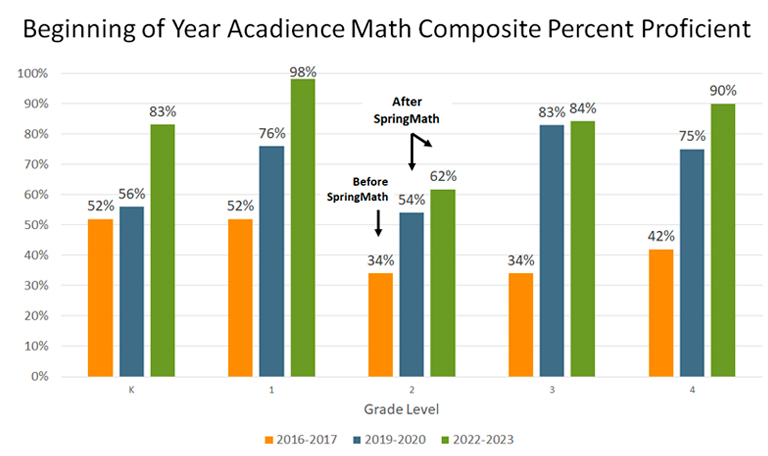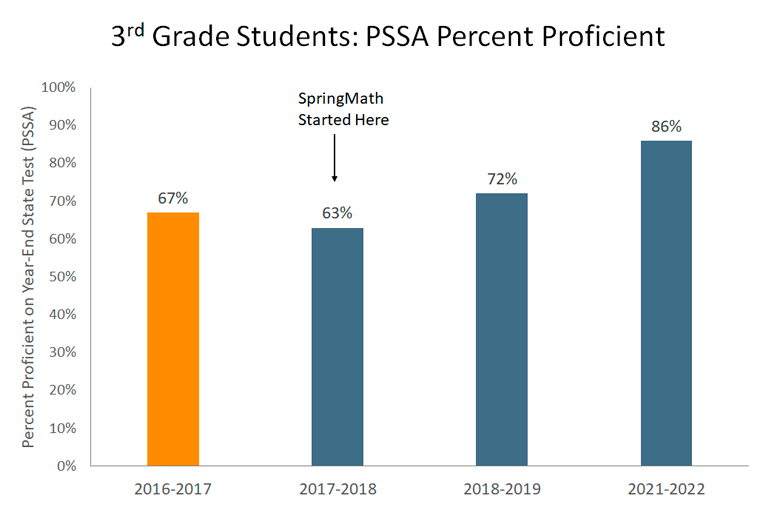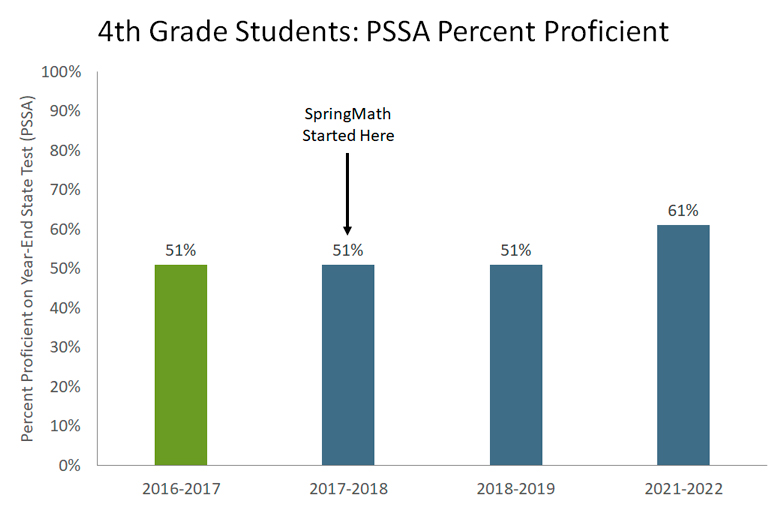Among the streamlined assessments, simplified interventions, and more, Renee Lepley, principal at North Star Central Elementary School, and her colleagues knew SpringMath could help their students master important concepts and build confidence.
Yet, despite a strong plan in place, Lepley and her colleagues never could have imagined the COVID-19 pandemic’s impact on students’ academic — and even nonacademic — skills.
At the end of 2022, the National Assessment of Educational Progress (NAEP) shined a light on what leaders feared — a significant drop in students’ math scores nationwide. Nationally, fourth-grade math scores decreased by five points, and eighth-grade math scores by eight points.
However, despite these nationwide trends, students’ math scores at North Star Central Elementary School improved throughout the pandemic — and continue to improve.
Creating a foundation for growth
While COVID-19 forced schools and districts to adapt and embrace remote learning almost overnight in the spring of 2020, teachers at the Pennsylvania district hardly skipped a beat, continuing to use SpringMath — an award-winning math intervention solution — with their students to ensure learning and growth continued.
Lepley shared, “We were very excited to see this increase in scores. We were very nervous that remote learning set us back. Thanks to SpringMath, we were able to continue to provide our students with classwide and individual intervention remotely, which helped to keep most students on track.”
Charting a clear path forward
These impressive scores didn’t happen by chance. SpringMath, designed as an efficient, turnkey solution for math proficiency, meets students where they are in math and readily repairs skill gaps daily until mastery improves.
Since most learning occurs from fall to winter, SpringMath starts the school year with a 15-minute, whole-class assessment. Teachers input the scores into the database, and simple-to-use, actionable reports appear.
The first report determines the probability of students who are at risk of failing a year-end math test. Most beginning-of-the-year classes fall within an 11–49% range of risk, and daily, 15-minute, whole-class intervention is recommended. Interventions are scripted, practice materials are provided, and activities are spelled out. Teachers, spared the heavy lifting of gathering and preparing materials, are free to move on with instruction.
After a few weeks of classwide intervention, the data show which students are lagging and who may benefit from individual intervention. Once again, personalized practice materials are at hand to help individuals with specific skills. Ongoing interventions are adjusted every week based on student performance.
"We were very excited to see this increase in scores. We were very nervous that remote learning set us back. Thanks to SpringMath, we were able to continue to provide our students with classwide and individual intervention remotely, which helped to keep most students on track."
- Renee Lepley, principal at North Star Central Elementary School
Ensuring math mastery
To aid in mastery attainment, SpringMath introduces math concepts at an earlier age than most classrooms. At North Star Central Elementary School, fractions were initially introduced at the fourth-grade level, causing difficulty for both students and teachers. Now, simple fractions are taught in third grade, and the concepts are built upon each year until students are ready for a rigorous roll-out of fractions at the fourth-grade level.
The MTSS math team members put many hours into focusing on gaps in the standards and curriculum throughout the grade levels and ways to fill those gaps. Teachers built a curriculum tree, where concepts are introduced at earlier ages so when students get to the grade level that covers the standard, they already have the foundational knowledge.
Time and Money bell ringers are done buildingwide in every math class. A common language glossary was also created, so teachers are using the same vocabulary from kindergarten to fourth grade. The math teachers explicitly teach new math words and give students multiple exposures to the words throughout the grade levels.
“My math teachers are all on the same page. Math class doesn’t seem like the most obvious choice for word walls and glossary lists, but we believe a strong understanding of math terms has been essential for mastering concepts,” Lepley explained. “Math classes can move pretty fast. There’s so much for teachers to cover in the course of a school year. Our math curriculum tree takes some of that stress off of teachers because it is now a gradual process.”
The consistent, relevant practice and concept building through grade levels produce enduring math mastery. While many conversations during and after the pandemic focused on learning loss nationwide, North Star Central Elementary School, with the help of SpringMath, continued to produce high-quality math instruction and interventions. Now, their students are on track and moving forward at grade level.
An ongoing vision meets success
SpringMath lives up to its claims. Lepley’s elementary classes continue to reap the benefits of efficiently implementing the framework with fidelity. Students are ready for grade-level work on time, and state math scores continue to rise. Lepley’s vision of helping all students forge a path to math mastery remains front and center and attainable going forward.




